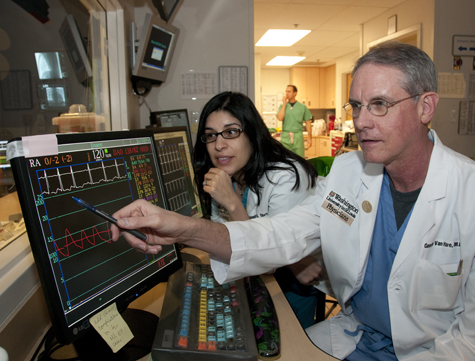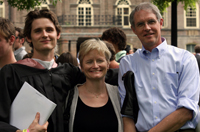
Robert Boston
George Van Hare, MD (right), the Louis Larrick Ward Professor of Pediatrics, looks at data from a patient’s heart with Jennifer Silva, MD, instructor in pediatrics and director of pediatric electrophysiology. “George is a natural leader,” says Alan L. Schwartz, PhD, MD, the Harriet B. Spoehrer Professor and head of Pediatrics. “He empowers others and leads by example. He is a superb cardiologist, teacher, mentor and citizen. We are thrilled that he is at Washington University School of Medicine and leading pediatric cardiology on to the next level.”
For someone who grew up on the East Coast and spent much of his career on the West Coast, George Van Hare, MD, certainly seems at home in the Midwest.
Van Hare, chief of the Division of Pediatric Cardiology, arrived at Washington University School of Medicine and St. Louis Children’s Hospital in 2008 from northern California after some soul-searching prompted him and his wife, Michele “Middy” Estabrook, MD, also a pediatrician, to change the focus of their successful medical careers.
“For nearly 20 years, my career had focused on innovating new procedures to cure heart rhythm problems in children,” Van Hare says. “I was part of the revolution in nonpharmacologic care of arrhythmias in children. I loved it, but I decided I wanted my career to take a different turn. At the same time, my wife had an ambition to be more involved in medical education, so we looked for somewhere we could go together.”
Before Van Hare arrived in St. Louis, he was a professor of pediatrics at Stanford University, where he specialized in pediatric cardiac electrophysiology, a specialty involving the study and treatment of abnormal heart rhythms. He and Estabrook were recruited there in 1998 to become part of UCSF Stanford Health Care, a not-for-profit corporation created through the merger of the Stanford and the University of California, San Francisco, medical centers.
Despite the dissolution of the merger in 1999, Van Hare organized a system that brought all pediatric electrophysiology cases in northern California to his team at Stanford, creating the largest pediatric electrophysiology operation in the country at the time. For his last several years there, he also was the fellowship-training program director in pediatric cardiology.
When Van Hare and Estabrook started looking at other medical centers, they both found what they were looking for at Washington University and St. Louis Children’s Hospital.
“There are a lot of wonderful children’s hospitals that aren’t associated with a premier medical school, and a lot of medical schools that don’t have the kind of children’s hospital infrastructure that allows them to be as good as they could be,” Van Hare says. “This place has them both, and they are not just adequate, they are both absolutely spectacular. It inspired me because of all the potential.”
Van Hare also cited the university’s renowned work treating children with failing hearts, the adult electrophysiology practice and the echocardiography lab. He wanted to work with Charles Canter, MD, professor of pediatrics and medical director of the cardiac transplant program at St. Louis Children’s Hospital, and Yoram Rudy, PhD, the Fred Saigh Distinguished Professor of Engineering and director of the Cardiac Bioelectricity and Arrhythmia Center.
Van Hare was named the Louis Larrick Ward Professor of Pediatrics at the School of Medicine, and Estabrook joined the school as a professor of pediatrics.
“George is a natural leader,” says Alan L. Schwartz, PhD, MD, the Harriet B. Spoehrer Professor and head of pediatrics. “He empowers others and leads by example. He is a superb cardiologist, teacher, mentor and citizen. We are thrilled that he is at Washington University School of Medicine and leading pediatric cardiology on to the next level.”
As division director, Van Hare spends a lot of time on administrative tasks, but he also mentors Jennifer Silva, MD, instructor in pediatrics and director of pediatric electrophysiology. He spends one day a week in clinic and two days a week working in the pediatric electrophysiology lab, which he says is addictive.
“In some ways, if you parked me in the electrophysiology lab and gave me five days a week to do procedures, I’d be happy as a clam,” he says. “There’s something incredibly fulfilling about taking a child with a dangerous or troubling heart rhythm issue, spending a few hours with them and basically curing their problem, then sending them off to live their life.”
Discovering academic medicine
Although Van Hare spent most of his life on the coasts, he was born in Kansas City, Mo., and spent several years training in Cleveland. He served a year at Cleveland’s Rainbow Babies & Children’s Hospital as a chief resident and then worked for two years at Cleveland Metropolitan General Hospital as medical director in a clinic for teenage mothers and their babies.
While there, he also got involved in ear disease research, particularly otitis media, or middle ear infections, and published results of some clinical research.
“One might think a bunch of publications on otitis media are irrelevant to my cardiology career, but it was highly relevant because that’s where I honed my skills as an academic pediatrician,” Van Hare says.
Taking his show on the road
Van Hare also makes a few visits a year to Kapi‘olani Medical Center for Women and Children in Honolulu.
Along with John Lamberti, MD, a pediatric cardiac surgeon at Rady Children’s Hospital San Diego, Van Hare and other physicians put in pacemakers, perform cardiac catheter and electrophysiology procedures and treat other heart problems in Hawaiian children and children of American service personnel stationed in the Pacific.
“It would be a tremendous hardship for these patients to come to the mainland for treatment,” he says. “So five times a year, we turn the hospital into a high-volume pediatric cardiology/cardiac surgery program.”
Throughout the year, he serves as the principal consultant to the local cardiologists for pediatric arrhythmia problems in Hawaii.

Courtesy photo
(From left) Mark Van Hare, Michele “Middy” Estabrook, MD, and George Van Hare, MD, at Mark’s 2010 graduation from Vassar College.
From this experience, Van Hare has observed how the U.S. military uses telemedicine consults to extend the reach of their subspecialists and to determine whether a patient needs to travel immediately for health care or can wait until a scheduled visit.
Since his arrival in St. Louis, he has been involved with a multidisciplinary telehealth initiative at St. Louis Children’s Hospital. The cardiology division soon will able able to offer telemedicine consultation, including the capacity to listen to a patient’s heartbeat and other body sounds with a stethoscope from a distance.
Other work travel includes trips to Turkey, Moscow and New Zealand as a visiting professor and a speaker at conferences. While there, he often works with local cardiologists performing various advanced electrophysiology procedures.
Van Hare says he and his family quickly felt at home in St. Louis and made many new friends. He joined the choir at Trinity Presbyterian Church in University City, and he and Estabrook enjoy frequent St. Louis Symphony Orchestra performances and visiting area restaurants.
They have three sons: Colin, a student at the University of Missouri-St. Louis and a former chef; Mark, a recent graduate of Vassar College working in sound design in New York City; and Christopher, a junior at Clayton High School. The family also recently adopted an Australian Shepherd puppy.
“St. Louis is a very well-kept secret,” he says. “It is just a really small world. Everybody seems to know everybody, and I really like that.”
Fast facts about George Van Hare, MD
Hobbies: Singing in the choir at Trinity Presbyterian Church
Favorite restaurants: Eleven Eleven Mississippi, Vin de Set, Modesto and other local bar and grills
Education: BS, Bates College; MD, University of Connecticut
Training: Residency: Case Western Reserve University; fellowships: Cleveland Metropolitan General Hospital, pediatrics, and University of California, San Francisco, pediatric cardiology and adult electrophysiology; visiting fellow: Baylor College of Medicine, pediatric electrophysiology